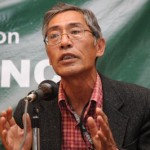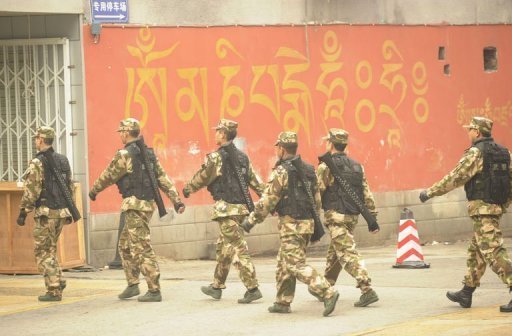Article Source: (Source)

Author: Thupten Samphel.
October 26, 2016: The importance of the Tibetan plateau to Asia is threefold: geopolitical, cultural and environmental. What China does or does not do in Tibet has geopolitical, cultural and environmental consequences for the rest of Asia.
Geopolitically, Tibet served as an effective buffer between two of Asia’s most consequential powers in history: India and China. Thrusting almost three miles in the sky and covering an area of 2.5 million square kilometres, and surrounded on three sides by some of the highest mountain ranges in the world, Tibet kept the peace between the two Asian giants by geographically and physically separating the two. In 1950 that buffer was breached when resurgent communist China invaded and occupied Tibet. The breach of the buffer resulted in India and China coming to blows in 1962.
The ambivalence in relations between India and China is a product of the breach of Asia’s most important buffer and the un-resolved issue of Tibet. With this breach, the Tibetans lost a country and India a cultural cousin. Because of the residue of distrust left over from the 1962 war between India and China, some experts define this important relationship as one of cooperation and competition. If this assessment of relationship between the two Asian giants is accurate, then striking the right balance is critical for India. How cooperation in trade between the two does not blindside India to China’s geopolitical goals in the region and how India’s strategic distrust does not prevent it from the reaping benefits of booming trade with China is a challenge for Indian diplomacy.
Today China is in firm control of Asia’s erstwhile buffer. A network of highways, an expanding railway line branching out to connect strategic locations in Tibet and beyond, a growing number of airports, and Beijing’s increasing militarization of the plateau make China’s position in Tibet unassailable. All this infrastructure development in Tibet is cemented by a rash of urbanisation to be populated by migrant Chinese. Reports are coming out that the Tibetan town of Dram along Tibet’s border with Nepal ravaged by the earthquake that devastated Nepal in April will be rebuild and repopulated by Chinese settlers. Reports say the original Tibetan inhabitants of the town will be moved up north near Shigatse, Tibet’s second largest city.

From the Chinese perspective these are indeed remarkable accomplishments in one of the most hostile terrains on earth. And the message of Chinese triumphalism that kept beat and tone of the impressive parade before the Potala Palace in Lhasa in early September to commemorate the 50th anniversary of the founding of the Tibet Autonomous Region was one of that China coming of age in Tibet. In official pronouncements, Beijing declared that Tibet had entered “a golden age.” The Tibetan people are happy and prosperous as they have never been before. China’s State Council produced two white papers on Tibet this year alone to drive home the point to the internationalal community and perhaps to President Barack Obama whom the Chinese president Xi Jinping in his state visit met a few days ago in Washington, DC.
All this display of Chinese triumphalism hides a big weakness: China has won Tibet but lost the Tibetan people. This is China’s Tibet headache. No ruler has so thoroughly succeeded in alienating the ruled as China has done with the Tibetans.
An indication of the great Tibetan alienation from Chinese rule is the number of protests that erupt on the plateau. Despite being under total and effective lockdown with “nets in the sky and traps on the ground” and surveillance cameras everywhere, and regardless of harsh reprisals for any potential protest, Tibetans continue to protests. Since 2009, these peaceful protests have taken the form of self-immolations. Since 2009, nearly 142 Tibetans have set themselves ablaze, calling for freedom in Tibet and the return of the Dalai Lama to his homeland. There are no signs that this form of protest will end until Beijing positively addresses the Tibetan people’s concerns.
China is trying to un-do this great Tibetan alienation with a mixture of carrot and stick policy of speeding economic development financed by central government subsidies and political repression. But these days China is doing something else that might have far deep repercussions with the Tibetan people and within the international community. The Chinese Communist Party is claiming that it alone has the right to appoint the next Dalai Lama.
By making such a claim China is asserting its spiritual sovereignty of the souls of the Tibetan Buddhists. Such claims are similar to China drawing the nine dashed lines on the disputed South China Sea which has alarmed other claimants like Vietnam, Indonesia, and the Philippines. The Chinese Communist Party’s claims to the right to appoint the next Dalai Lama or any other incarnate lamas will provoke the ire of not just Tibetans but all people who once looked to Tibet as the fount of their culture. Tibetans and non-Tibetans alike who have traditionally embraced Tibetan Buddhism as the source of their spiritual heritage will not accept any attempt by the Party to corrupt what they consider their precious heritage. By making such claims, the Chinese Communist Party is not only intruding into Tibet’s spiritual space but by default also into that of India’s. No culture will accept the submission of its highest inspiration to the Chinese Communist Party. Such an attempt will widen the alienation between the ruler and the ruled in Tibet
The other equally intimate connection Tibet has with the larger Asian community is its environment. Scientists these days refer to the Tibetan plateau as “the Third Pole,” being the repository of the largest concentration of ice and snow outside the two Poles. Chinese scientists call Tibet as “Asia’s Water Tower.” This concentration of the third largest glaciers in the world feed the ten major river aabout 47 percent of the earth’s total human population. This means what China does in Tibet have consequences for countries downstream. Experts point out that China is on a frenzied dam-building and water-diversion scheme along rivers that flow from Tibet to the rest of Asia. China, of course, denies all this. But if the experts are right, will Asia be in a position to make China answerable to the consequences? Experts say many of these dams are built on areas of high seismic activity. And if reports of China’s water-diversion schemes are correct, this will leave the rest of Asia high and dry. China can turn on and off Asia’s tap in Tibet.

